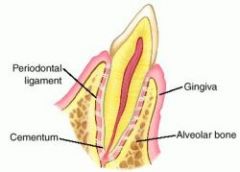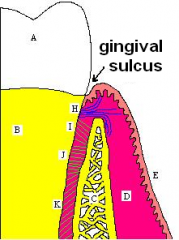![]()
![]()
![]()
Use LEFT and RIGHT arrow keys to navigate between flashcards;
Use UP and DOWN arrow keys to flip the card;
H to show hint;
A reads text to speech;
20 Cards in this Set
- Front
- Back

what are the 4 functions of the periodontal ligament
|
1. it is the tissue of attachement between the tooth and the alveolar bone,it is responisble for resisting displacing forces on the tooth and in so doing, protects the nerves and the blood vessels at the root apex
2. responsible for the mechanism whereby the tooth attains and maintains its functional position, e.g. eruption and mesial drift 3. it cells maintain and remodel the adjacent bone and cementum 4. it contains mechano receptors which provide sensory input for jaw reflex activity. |
|
|
what does the ligament resist and in doing so what does it protect and prevent
|
how the it resists intrusive loading
on the tooth and in so doing protects the delicate tissues at the base of the tooth and prevents the root apex from impacting the bone at the socket base |
|
|
to an uneducated person what may he think occurs when a load is applied to a tooth.
why is this wrong |
One might expect that when a load is applied to the
tooth, the tooth would intrude a small distance into the socket and tension would be generated within the oblique fibre system and further tooth movement would cease. The ligament would thus act like a simple suspensory ligament. However, much of the experimental data does not support this simple suspensory ligament form of tooth support |
|
|
how can the pattern of intrusive behaviour of a tooth be determined
|
If tooth position is monitored continuously (in this
case with a sensitivity of approximately 1μm) its pattern of intrusive behaviour can be determined |
|
|
WHAT HAPPENS WHILST THE TOOTH IS UNLOADED
|
While unloaded the tooth remains static in its socket
and the trace is steady (apart from the small pulsatile movements in synchrony with the heart beat). |
|
|
EXPLAIN THE 2 PHASE SYSTEM ONCE A LOAD IS APPLIED
WHAT IS THIS SYSTEM TERMED |
When
a load is applied to the tooth there is an initial rapid intrusion, the so-called ‘elastic’ phase. However, if the load is maintained the intrusion continues at a much slower rate but over a much longer period of time – this is the so-called ‘creep’ phase. This second phase, if given time, will produce a much larger overall intrusion than the initial ‘elastic’ phase. This biphasic response is termed ‘visco-elastic’. |
|
|
WHAT HAPPENS AFTER THE LOAD IS REMOVED
|
If the load
is then removed, there is an initial rapid (elastic) recovery and then a much slower extrusion which again, given time, will restore the tooth to its original position |
|
|
WHAT IS DIFFICULT TO EXPLAIN
|
It is difficult to explain these characteristic
biphasic responses simply on the basis of tension generated within the oblique fibre system. |
|
|
OUTLINE ONE OF THE EARLIER EXPERIMENTS CONDUCTED TO INVESTIGATE THE MECHANISM OF TOOTH SUPPORT
WHAT DID THIS MECHANISM SUGGEST |

One of the early experiments conducted to
investigate the mechanism of tooth support was to measure the distance (‘A’) between opposing alveolar crests when a load was applied to the tooth. The expectation was that when the load was applied tension would be generated in the oblique fibres, the crests would be pulled together and therefore distance ‘A’ should decrease. In fact distance ‘A’ increased, indicating that the crests had been pushed apart. htt |
|
|
OUTLINE ANOTHER WAY TO STUDY THE MECHANICS OF TOOTH SUPPORT
|
Another way to study the mechanics of tooth support
is to look at the stress/strain curve for the oblique fibre system and compare it to other well characterised connective tissues, |
|
|
DESCRIBE WHAT THE STRESS/STRAIN CURVE PLOTS/SHOWS
|
The stress/strain curve plots the %age
increase in length of the tissue (the strain) as the load applied (the stress) is increased until a point is reached where damage occurs and the tissue does not recover when the load is removed – the so-called failure stress and strain. |
|
|
WHAT IS EXPECTED OF THE ACHILLES TENDON
WHAT DOES THE STRESS STRAIN CURVE SHOW ABOUT THE ACHILLES TENDON |
In the case of a typical
tendon such as the achilles tendon very large loads are required to produce little in the way of extension and failure occurs at only approximately 10% strain. We would expect this of a tissue who’s function is to transmit tension generated by a muscle directly to a bone. |
|
|
HOW DOES THE STRESS/STRAIN CURVE FOR THE ACHILLES TENDON APPEAR IN COMPARISON TO THE SKIN
|
Compare this to the skin, a very elastic and
pliable tissue, where only very modest increases in load produce large increases in strain with failure occurring at approximately 45% strain. |
|
|
FROM WHAT DATA WHAS THE STRESS/STRAIN CURVE FOR THE PERIODONTAL LIGAMENT
|
dissected pig jaws were used with the
base of the socket removed. Increasing loads were then applied to the tooth and the displacement into the socket recorded until sufficient stress was applied for the oblique fibres to be ruptured. From these data the stress/strain curve could be constructed, |
|
|
WHAT DOES THE STRESS STRAIN CURVE SHOW FOR THE % STRAIN AT WHICH FAILURE OCURS IN THE PERIODONTAL LIGAMENT.
WHAT IS IT SIMILAR TO WHAT IS SIGNIFICANT IN THESE RESULTS |
both in terms of its shape and failure stress and strain, with failure occurring at approximately 20% strain. Interestingly this is very close the stress/strain failure point for foetal, as
opposed to adult, tendon. This relatively low failure stress value for periodontal oblique fibres is significant given the relatively large loads that people are known to apply to teeth during normal mastication, particularly in certain ethnic groups and cultures. |
|
|
IT IS CLEAR THAT OTHER ELEMENTS WITHIN THE TISSUE PLAY AN IMPORTANT ROLE IN
|
Whilst some of the load applied to the tooth is
probably dissipated through the oblique fibre system, it is clear that other elements within the tissue play an important role in this process |
|
|
WHAT OTHER POSSIBILITY IS CONSISTENT WITH MUCH OF THE DATA ALREADY OBTAINED
|
One possibility which
would be consistent with much of the data obtained so far is that a large part of the load is dissipated by fluid flow both within the matrix itself and within the capillary bed. When the tooth is intruded fluid will be relocated from beneath the tooth ultimately to the large blood spaces in the surrounding bone and to regions of the ligament further coronally. This would lead to increased fluid volume in the crestal region which in turn would tend to force the alveolar crests apart. |
|
|
WHAT DOES THE PERIODONTAL LIGAMENT DEMONSTRATE
|
The periodontal ligament demonstrates a
biphasic, ‘visco-elastic’, response to axial loading |
|
|
WHAT DO THE STRESS STRAIN CURVES FOR THE PERIODONTAL OBLIQUE FIBRES SHOW
|
The failure stress and strain of the periodontal
oblique fibres are more akin to foetal tendon than either adult tendon or skin |
|
|
WHAT DOES THE LIGAMENT APPEAR TO RESIST
|
The ligament appears to resist intrusive loads
primarily by compression and fluid flow |

